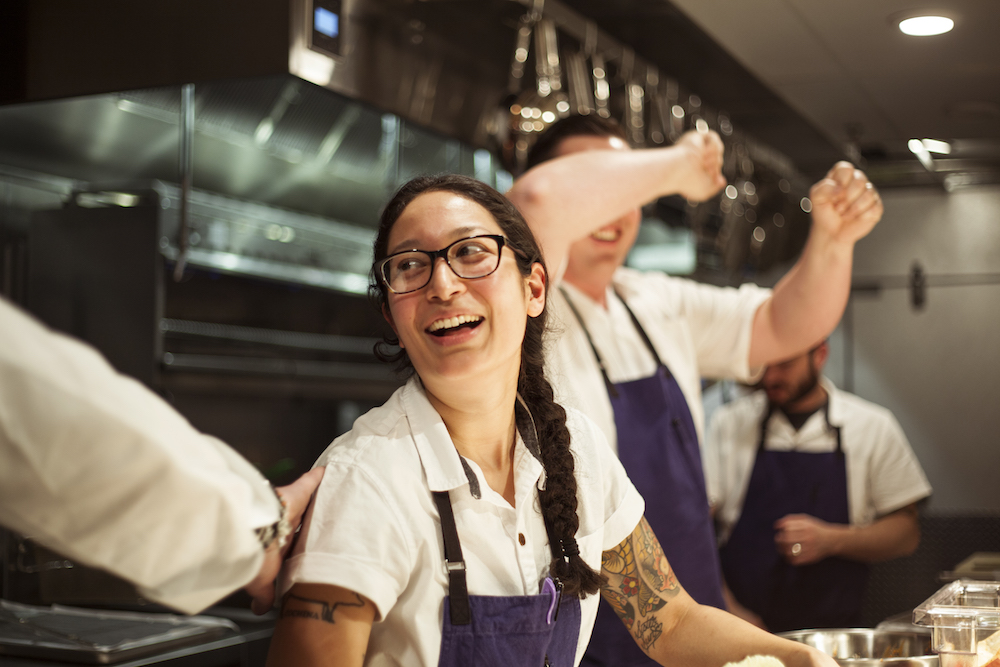The daughter of a Korean mother and Mexican father, Angela Hernandez grew up in a household where blending foods from very different cultures was the norm. It’s also the norm at Dallas’ Top Knot, where Hernandez is chef de cuisine. There, she blends Asian and Latin flavors and presents balanced and creative dishes.
We talked with Hernandez about how her upbringing influences the flavors she serves to customers today and what she loves about creating new dishes.
The Latin Kitchen: How did growing up with a Korean mother and a Mexican father influence your approach to cooking?
Angela Hernandez: Indirectly, I think. Now that I’m older I realize what a strong influence it was, but growing up, I never thought of it to be a focus or such an influence for me. In my family, eating was just always part of our culture and we always ate well. It was nothing out of the ordinary to have Mexican and Korean food on the table at the same time, to eat spaghetti with kimchi. It was just life.
TLK: Top Knot combines flavors of Southeast Asia, Latin America and Japan. Any reason they go together particularly well?
AH: Working with the group of people that I do, it just kind of progressed naturally. It’s funny because some of the items on the menu that are more speaking directly to my roots as Korean and Mexican are actually dishes that didn’t come directly from me, but that came from my sous chefs and cooks, cooking things that they like to eat and that inspire them.
There’s a pork belly and kimchi rice bowl on the menu right now that wasn’t even created by me. And we have kimchi and Korean fried chicken on the menu, and the amazing thing to me is that my cooks are the ones that gravitate toward that as well. [pagebreak]
TLK: What do you enjoy about cooking or coming up with new recipes?
AH: I enjoy the process. Starting with an idea and seeing it come into fruition and how that idea is sparked, that’s interesting. Sometimes it could be a recipe or dish that inspires us, or sometimes it could be just going to the museum and seeing certain colors pop and wanting to emulate that in some way through food.
And then I think the most exciting part of the process is that sometimes you want something to turn out a certain way and through mistakes or just fate, iit becomes something better or totally different from what you had intended it to be.
TLK: How do you combine distinct flavors without one overpowering the other or seeming out of place?
AH: It’s always a balance of flavors, which I think every chef keeps in mind. It’s a balance of sweet, salty, acid. Textures come into play, and then also another big one for us has always been to make sure that food is simple. We can complicate it and overthink it all we want in the kitchen, but the important thing for us is that once it hits the table, hits the guests, we want it to seem effortless. They don’t need to know that it took 36 hours to cook a piece of meat, they just want to taste it.
That’s why when I go out to eat, I’m not necessarily amused or impressed by technique. Technique is very important, but if something tastes good, you can taste the love and the care that went into the food. So for us it’s always focusing on starting with five core ingredients, making sure that they’re the best quality, and then trying to work within that number. Five seems like a good number of ingredients to work with as long as we can keep them really solid, good quality, good flavor. [pagebreak]
TLK: Are there any cultures whose foods you think would work well together but that you’ve never seen paired?
AH: I think in a sense, people, whether they realize it or not, are already developing different cultures and types of food, maybe just things that haven’t been as obvious. I know Korean food is becoming popular in the past couple years. I think Korean food is a type of cuisine that’s not been as socially accepted, and the funny thing is, Koreans aren’t necessarily the type of people that put themselves out there to share it — you either know how to eat Korean food or you don’t. But I think it will be interesting to see how it’s interpreted as it hits more mainstream in the next few years.
TLK: If you had to choose a career other than chef, what would you be?
AH: Gosh, I don’t know really what I would be good at. I feel like it might have to be food-related in some form, maybe a food writer would be kind of cool. I think I write better than I speak, because you can put more thought into it and if I apply myself it’s a nice creative outlet, and I think it would be cool to get paid to go out to eat and then write about it.
TLK: Do you have any events coming up that readers should know about?
AH: Absolutely. We launch our winter series in January, in which we’ll be inviting chefs in from outside of Texas, little more heavy-hitters, to collaborate on one-night dinners, so that should be really fun!


![Making Mealtime Matter with La Familia: Easy Sofrito [Video]](https://thelatinkitchen.com/wp-content/uploads/2015/10/sofrito-shutterstock__0-500x383.jpg)
![Easy Latin Smoothies: Goji Berry Smoothie [Video]](https://thelatinkitchen.com/wp-content/uploads/2015/12/goji_berry-shutterstock_-500x383.jpg)
















![Fun and Fast Recipes: Fiesta Cabbage Salad [Video]](https://thelatinkitchen.com/wp-content/uploads/2015/11/fiesta_cabbage_slaw-shutterstock_-500x383.jpg)









